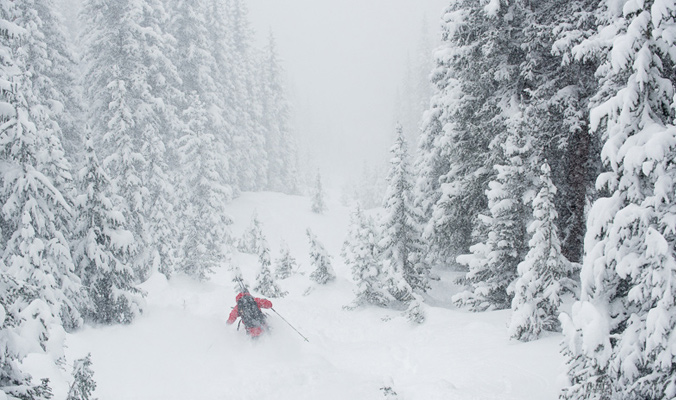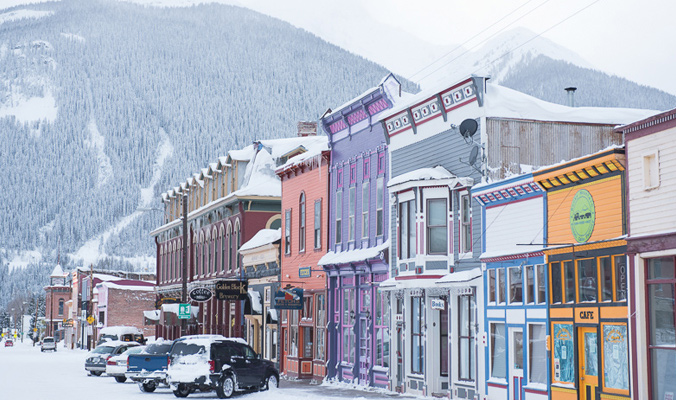Taking some in the San Juan Colo. backcountry community by surprise, a May 3 ruling by the Bureau of Land Management granted Silverton Mountain Guides a five-year Special Recreation Permit for helicopter skiing in the Illinois/Hancock, Minnie/Maggie, Round and Southeast management pods northeast of town.
The final decision gives heli access to more than 16,000 acres, but requires Silverton to no longer operate in Grouse Gulch, Cinnamon, Houghton, Poughkeepsie and Ross Basin, which accounts for around 5,000 acres. It’s a huge net gain in terrain (25,000-plus acres) for the operation and provides more low-angle, treed acreage. Naturally, it’s good backcountry terrain for high avy hazard days, too.
“The local backcountry community expressed concerns about the runs coming down onto County Road 2 so we took that off the table,” Silverton Mountain Guide’s COO Tim Petrick says. “All the easy access stuff was removed from the proposal.”
“The purpose of this new terrain is to be able to attract more people to make the trek to Silverton. Most of our guests will never Heli ski there, but it is an aspirational opportunity to access some new, hopefully better terrain,” he added. “It’s going to give us something to compete against the mega corporations that are taking over our sport.”
But some locals still think it’s Silverton Mountain Guides doing the taking over. And while the new permit doesn’t increase Silverton’s allotted 600 user days, thereby spreading out the same number of skiers over more than twice the terrain, some backcountry skiers and representatives of other public user groups aren’t satisfied.
According to the San Juan Citizen’s Alliance, more than 85 percent of the public comments were opposed to the original proposal. The ruling, says Jimbo Buickerood of the Alliance, is at best, “tone deaf.”
“These are our public lands. We don’t want the public’s use of them to be precluded for the sake of a business of any size,” he says. “We want all users to have a voice. We feel the BLM hasn’t listened.”
Petrick contends that the BLM’s ruling weighed both sides. “We took all of the easy-to-access CR 2 road runs off the table specifically to avoid probable user conflicts with skiers and snowmobilers,” he says, adding that the terrain farther east in this zone is seldom, if ever, accessed by backcountry users. “I just don’t see the potential for any material amount of user conflict, which is exactly the conclusion that the BLM came to when the issued their FONSI (Finding of No Significant Impact).”
While backcountry skiers can still access the newly designated zones, the ruling is unclear as to how user conflict will be mitigated. Most prescriptive language in the Environmental Assessment deals with avalanche control work and the handling of explosives. And the BLM doesn’t stipulate how Silverton Mountain Guides should communicate to the community as to when or where they’re flying or controlling. Buickerood thinks Silverton’s management could mitigate some of the remaining public angst through such communication, just as outfits do elsewhere in the U.S.
“I’d hate to see the Brills (Silverton’s owners) have to pay for an Environmental Impact Statement to address the deficiencies in the EA,” he says. “But they could have done a lot to avoid that route by stepping up and dealing with some of the public’s remaining concerns.”
Short of that, there is an appeals process.
“Do I think there will be appeals?” Buickerood concludes. “Yes.”
Editor’s Note: Adam Howard visited Silverton Mountain in January of 2016 and filed the following story in Backcountry’s February 2017 issue.
______________________________
The Old Man and the Ski Area
After 15 years, Silverton Mountain is growing up, and founders Aaron and Jen Brill know they need some wisdom to guide it. Enter former K2 chief Tim Petrick. And some controversy.

Silverton guide Marc Kloster on Splitski on the Mountain’s North face. [Photo] Jeff Diener
Saturday night, February 1, 2016, 11 p.m. Ours is the last car to make it over Red Mountain Pass from Ouray before CDOT closes Colorado Route 550. At an inch an hour, more than four feet of snow has fallen on the San Juans, redlining the avalanche danger in a range already known for its dicey snowpack.
Twenty minutes later, at the modest miner’s home of Silverton Mountain’s newest hire, I’m feeling apologetic given the hour. But former President and CEO of K2 Sports and, now, Silverton’s Chief Operating Officer Tim Petrick comes to the door weather ready. “I’m heading up to the lift,” he says with a fired-up grin. “I want to see how much snow we’ve gotten since close.”
When Tim says “lift” he means the only chair at Silverton Mountain, now celebrating its 15th year carrying guided and unguided skiers and snowboarders straight into the heart of some of the most complex and dangerous terrain in the highest state. No groomers, no signs, no restaurant, no lodging. Its guides are the patrol and snow-safety crew.
We hop into Tim’s late-model Audi and head for County Road 110, the only way to the ski area and the unmitigated backcountry beyond that’s frequented by Silverton locals. The car’s fancy headlights are the kind that anticipate each hard turn: handy when your dark and daily commute covers countless corners and crosses seven avalanche paths, many of which are controlled by explosives dropped from Silverton Mountain’s three-year-old AStar B3 helicopter, on call with the San Juan County road crew. And, also, on call for a substantial number of destination clients willing to kick down for a single or multi-drop or even a full-day helicopter-skiing experience into and around the giant Colorado Basin east of the lift-accessed terrain.
In the black on white parking lot Petrick gets prone in those headlights, hunched over a folding pit-kit ruler. I’m struck for a moment at how, aside from the car, so much has changed for he and his wife, Michelle, in the last several months.
Seattle to Silverton is no small change. At K2 he might argue with a factory in Asia one day and try the next to get his European subsidiary to meet 4.5-percent parent-company growth expectations. Now he’s getting paid to buy a used woodstove on Craigslist and install it in Silverton Mountain’s base tent. As his ruler reads three inches, I think of a line of his I picked up in France on a ski tour we did together in Chamonix a few years back: “That’s pretty granular for me.” Translation: The topic at hand (something to do with the marketing of a K2 ski) was way, way outside of his purview. Now, he brags about the new coffee maker initiative in the tent.
[aesop_quote type=”pull” background=”#ffffff” text=”#000000″ width=”676″ height=”200″ align=”left” size=”1″ quote=”My dad told me to find something to do with your life that doesn’t seem like work.” cite=”-Tim Petrick, Silverton Mountain C.O.O.” parallax=”off” direction=”left” revealfx=”off”]
You see, at K2—and before that Rossignol, and before that Olin, Powder Magazine, Aspen Skiing Club, Bear Valley California and Stowe—Petrick’s job was to hire really good people to make those sorts of decisions. He was the boss. He, genetically, is a leader and one who’s well respected by employees, shareholders, colleagues and anyone who’s ever seen him ski. Anyone including Silverton Mountain founders Aaron and Jen Brill.
“I met [Jen and Aaron] originally when they were two bright-eyed kids at the SIA tradeshow in Vegas,” Tim recalls as we head back down CR110. “At the time I was VP (of K2). They presented this concept to me, and I said, ‘No way.’ Backcountry skiing was a woolie-knickered crowd, and I thought they were crazy. They were going to put up a lift and let people ski backcountry. In the context of the time, it seemed like a fantasy.”
Aaron’s idea was loosely based on what he had discovered on New Zealand’s South Island in the 1990s, where surface lifts service snowfields. There, lifts just run, and you get on them and go where you wish. A little skinning from the top can pay off big.
In lawsuit-happy America, however, that payoff might be big for some suit in Phoenix after his client got a bloody nose at altitude. Plus, a chairlift in hard-to-get-to Silverton on a chunk of rock would be incredibly hard to mitigate for avalanches. It was, and is, a business model based on a dream that skiers would get. Early on, thrilled locals had a run on the place with an inexpensive, unguided option that made Silverton much like, say, La Grave in France: Ski at your own risk. But the business model wasn’t working, especially when dealing with American insurance companies and Feds managing the Bureau of Land Management land on which the Brills operated. Maintaining seven miles of rope and dozens of signs takes a lot of man hours. So it was evolve or die.
Over time, “reality caught up to Aaron,” Tim says. And Aaron and Jen took the difficult and, to many locals, unpopular step to more guided skiing at more money per day. Unguided skiing would only happen in the early and late season. Then they expanded farther into Colorado Basin, gaining control and shutting off backcountry access for much of the season, jading more townies.
The original plan wasn’t happening. Yet even many of the critics at the time recognized that you can’t turn a lift, and staff patrol and guides, without cash. And there was still plenty of backcountry terrain on Red Mountain Pass, farther up CR110 or out CR2, where many user groups share access and the goods.
To diversify the business, four years ago, Aaron and Jen bought the helicopter to provide for clients willing to pay for more powder and more vertical. They also started guiding in Seward, Alaska in the fall and spring seasons. That’s a long season for any resort pro. Throw in travel and management, and something had to give. Or, Jen says, something had to be gained so they could do it all and raise their son without killing each other.

Brill’s AStar flies the Chugach from Seward and the San Juans from Silverton. [Photo] Jeff Diener
“Aaron had done a great job at finding help in lift maintenance and snow safety; operations in general,” she says. “The business grew so fast, so quickly, I couldn’t really wrap my head around getting myself out from beneath an avalanche of paperwork. And every time I would think that I could see the light, my dreamer husband would start a new aspect of the business.”
Like most entrepreneurs, she says, she and Aaron did “everything.” And, everything stays with you night and day. So, they were looking for an objective third party, someone who could, essentially, understand Aaron’s dreams and, at times, bring him back to earth.
“To have somebody that can hike our mountain and wants to ski powder all day, yet can still go into the office and operate at such a high level,” she says of Tim, “it’s amazing.”
But some locals feel there’s more to the story; that by bringing in an industry heavyweight like Petrick, the Brills must be up to something more, and rumors flew. And, coincidentally, Tim’s arrival came just after the Brills sought an Environmental Assessment to get a permit for 35 square miles of new heli-ski terrain around CR2, the only other plowed county road in San Juan County.
“A lot of the negativity that we’ve experienced of late has to do with the fact that people don’t believe that Tim would want to work with us,” Jen says. “‘There must be some scheme. Why would you want to hire someone with that much experience unless you’re about to blow it up?’”
But, the truth is, it was just Tim’s time. And Silverton Mountain was the right place for both he and Michelle, who teaches skiing down the road at Purgatory Resort.
In 2015, as K2’s corporate master Jarden struggled to find room for skis and boots on the shelves next to their Rubbermaid and Mr. Coffee lines, Petrick, 63, saw the writing on the wall in Seattle for the company he helped guide, on and off, for two decades. That same year, he ran into Jen at the National Ski Areas Association Convention. And she needed help.
“There are people that try to read some sort of hidden secret strategy in all of this,” Petrick says. “It’s really as simple as those two people (Jen and Aaron) love to slide down snow-covered mountains. And if you can make ends meet with that, and you can create a sustainable revenue-exceeds-expenses model, that’s really it. It’s really about making sure the parking lots are plowed.”
[aesop_quote type=”pull” background=”#ffffff” text=”#000000″ width=”676″ height=”100″ align=”left” size=”1″ quote=”They presented this concept to me, and I said, ‘No way.’ Backcountry skiing was a woolie-knickered crowd, and I thought they were crazy.” parallax=”off” direction=”left” revealfx=”off”]
Regardless of the motivations that brought Tim to town, the terrain Silverton Mountain is seeking to access around CR2 is a deal breaker for many locals, no matter who’s in charge.
“To me, it’s too close, and it’s unnecessary,” says Jared Boyd, a Silverton backcountry skier, woodworker and outspoken critic of the expansion. “It seems clear that Silverton Guides is looking for ways to close their margins, increase profits: Quick, high altitude, front-country drops would accomplish this. But they’re stepping beyond what I think is reasonable. If they get it, it’s one less place people can go where they’re not hearing helicopters and bombs all day.”

Downtown Silverton, Colorado. In Summer, it’s bumper to bumper. In winter, snow piles 15-feet high in the center of the wide streets. {Photo] Jeff Diener
He’s not alone. According to Winter Wildlands Alliance, 80 percent of the letters the BLM received during the EA’s public comment period opposed the expansion for reasons ranging from avalanche control over a public road to snowmobiling and ice-climbing access to lynx habitat. It’s complicated.
And yet, many of the same comments came with caveats like Boyd’s: “I’m super supportive of Silverton Mountain.” Just not where he ski tours.
The BLM will announce its decision on whether or not the Brills get their new tenure this spring, probably well after Aaron has piloted the AStar back to Seward. Until then, for Petrick, it’s about the granular things like getting the parking lot plowed and making sure the coffee’s hot in the tent. It’s a great job, he says. And, he knows this is probably where his career will end. By all measures, it’s been a good one.
“My dad told me to find something to do with your life that doesn’t seem like work,” he says. “Really, all I wanted to do in my life was to go skiing anyway.”










Related posts:
Beer Guide 2017: A Bitter Breakdown
How world-champion freeskier Alison Gannett slashes glass ceilings
2017 Beer Guide: Higher Test
2017 Beer Guide: Hop Bombs